Abstract
The consensus in the Norwegian construction industry is that the projects are characterized by conflicts. Because unresolved disputes that reach courts take time and resources to be solved, this leads to lost productivity and high costs for all stakeholders. Of the root causes of conflicts identified previously, tender specification and contract understanding were the most significant issues. To expand on previous findings, a qualitative analysis of 58 formal, semi-structured interviews was conducted to determine whether personal characteristics and types of contracts presented conflicts. Interviews were conducted with contractors, public clients, consultants, academics, and lawyers. Data were analyzed using NVIVO 12.0 following specific relevant themes and thematic maps. Corrective and preventive actions included the development of a new method to produce better-prepared tender documents, knowledge building in contract management, training to ensure better communication and dialogue between client and contractor, trust-building, dispute resolution along the way, and avoid awarding contracts at the lowest price or the use of a hybrid model. Improved routines may drive costs down, and cooperation and new forms of tendering and contracting could be the key to prevent and minimize disputes in Norway.
Keywords:
disputes; construction; prevention; contracts; 8D; tender; infrastructure; communication; Norway 1. Introduction
Persisting disputes in the roads and tunnels construction industry can, if they end in a lawsuit, be expensive and affect the relationship between stakeholders. Between 2015 and 2017, 7 of Norway’s largest contractors were involved in 37 disputes totaling NOK 5.1 billion, of which 93% concerned a public client []. Furthermore, because an average of only 30% of contractors’ claims are awarded [], there is considerable disagreement in the construction industry. Therefore, cost saving is a tangible goal, provided disputes are settled at the earliest.
The reasons for disputes range from uncertainty in projects and inadequate risk analysis to poor communication between owners and contractors, with each possible cause having different degrees of severity. To understand how disputes in construction projects can be prevented in Norway and, indeed, internationally, the reasons and factors prevailing in most disputes were examined in a previous study []. The four root causes of conflicts in the Norwegian construction sector were tender specification, final settlement, changes in projects, and low-priced contracts. These findings are backed by the experience of experts and were revealed during debates and discussions with experts in the construction industry.
Of the four root causes of disputes in construction projects, change orders were one of them. In Figure 1, the percentage of changes in eight Norwegian construction projects is shown. It can be seen that average of changes in work comprised 31% of the contracted volumes of these 8 heavy construction contracts implemented in a period of 10 years, indicating the level of uncertainty in heavy construction projects in Norway []. Disputes, particularly in large contracts, make it both risky and challenging for contractors to include projects in their portfolio, as they have to be risk-averse and offer a high level of liquidity to withstand unforeseen costs []. Consequently, small entrepreneurs are loath to take on heavy construction projects [], affected by “duty of performance”, or “Hoppeplikten in Norwegian”. Duty of performance is anchored in Norwegian standards and obliges the contractor to carry out changed work, even if there is disagreement with the financial responsibility [,,,].
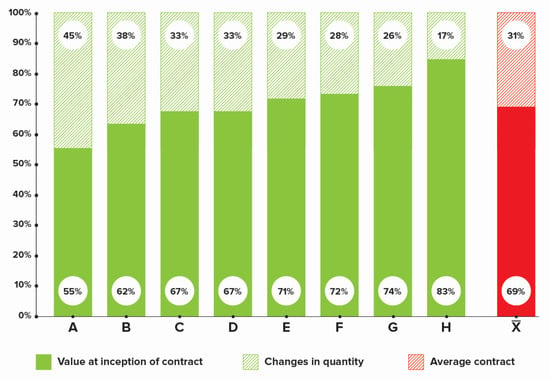
Figure 1.
Percent of changes orders in eight Norwegian heavy construction projects [].
1.1. Prevention of Disputes in Construction Projects
1.1.1. Confidence in the Industry
Lack of confidence arises when the contractors are uncertain whether they will be paid for the changes, while the client expects that the requirements the contractor fulfils will be more than what was demanded []. This is an unwanted development that can have a ripple effect and breaks trust between stakeholders. For example, in 2017, a contractor lost a lawsuit against a public owner that dealt with a settlement related to hassle and annoyance [,] because of the contractor’s poor documentation, among other reasons. In several cases, the contractor asserts that the client flatly rejects claims based on a lack of documentation [].
Challenges associated with changes have reduced confidence in the industry [] as claims related to changes can also be rejected without feedback or follow-up. However, “duty of performance” [] forces contractors to continue operations, even if the requirements are rejected.
1.1.2. Uneven Responsibilities and Obligations
As expected, “duty of performance” has resulted in many potential disagreements, including bankruptcy, arising from the contractor’s obligation to continue implementing changed work and what was agreed upon in the contract without negotiating a financial resolution []. This empowers the public owner who decides when and how much payments are released to the contractor. As well, disputed claims can be postponed until the final settlement while production continues as usual. Moreover, contractors must pay value-added tax (VAT) on 100% of their claimed invoice because, according to legislation, the contractor must invoice the costs of all changes, even when there are disagreements related to the change or cost [,].
1.1.3. The Ill-Effects of a Burgeoning Construction Industry
For many years now, the construction industry’s tremendous growth has increased contract amounts and pressure on the work force, which can reduce their quality that can be problematic, both for the client and the contractor. Indeed, despite the need for a quality work force and competent hands, the Association of Building and Construction Contractors (EBA) informed that qualified labour is scarce [,]. Studies have shown that conflicts are resolved more quickly if competent people sit on both sides of the table []. Competency arises from experience, which gives rise to scientific methodologies applied by the construction or project manager, who often supervises the contractual work. While in other countries, it is normal to have a quantity surveyor who works with costs and contracts [], if Norwegian contractors had sufficient contract follow-up resources, the number of disputes would have been reduced [], which is not usually the case.
1.1.4. Award Criteria and Contracts
With increasing complexity and project costs, public clients emphasize more on criteria such as implementation and solutions rather than the tender process price. Thus, the former is weighed to a greater or lesser degree despite the project cost being the most crucial []. Because this approach can give rise to conflicts [], the development of award criteria that minimize disputes in the construction industry is warranted.
Another source of conflicts and disputes is the notion among some public clients in Norway that incompetent employees work for some contractors []. This has resulted in public clients conducting interviews and checking the CVs of people involved in some contracts to ensure the quality of work that will be delivered [].
The lack of standardized contracts is known to create misunderstandings in future projects []. This is evident when examining large construction contracts, usually of the ‘design-bid-build’ type, wherein the client first contracts a consultant firm and then obtains a contractor []. The contractor receives the drawings at the start of the project but rarely prepares the design, which would have been the case if the contracts had been ‘turnkey or design-build’ types [].
Design-build contracts, which flow from the initial concept through the processes to completion, enable contractors to start on the field earlier because they have participated in the design process. Because design-build contracts may positively affect a number of disputes in the industry [,], increasingly, this type of contract is favoured by public clients in Norway. Standards for turnkey contracts (NS8407; []) and design-bid-built contracts (NS8405; []) show that the contracts are not quite standardized in terms of usage, and future contracts must be cognizant of this situation [].
As to the question of why contracts are not standardized, research has shown that disagreements occur despite using contracts as baselines, warranting the need to update and upgrade contract standards to minimize misunderstandings in future projects [].
1.1.5. Provisions in Norwegian Contracts Systems
The Norwegian Total Contract (NTK07 for 2007 and the updated version NTK15 for 2015) is a standard design-build contract that has been adapted from the offshore oil industry for use in construction projects. It owes its utility to an English translation and a parallel text in Norwegian/English [,].
NTK07 and its updated version, NTK15, regulate changes directed at the contractor in projects, not to exceed 15% of the contract amount. Because there is no limit on the number of changes for turnkey contract NS8407, a contractor proceeding with NS8407 can receive substantial change orders without being paid until after completion of the project [].
In the light of such eventualities, the client and contractor should agree on the value of these changes, particularly because, according to large contractors’ firms, road contracts are too large and risky without an agreement []. Despite having one, it is difficult to know if the pricing is right. Therefore, consistent information flow and contractors’ early involvement at the tender phase of the project will enable a reasonable and more accurate bid [], which will prevent conflicts.
Dispute resolution adopts a completely different pace due to rules and organizational procedure [] or when a project manager without the authority or competence is tasked with issues related to changes, including unforeseen changes, particularly with large contracts that require high-level discussions prior to approval [,].
1.1.6. Dispute Resolution in Norway
Resolving conflicts early as they arise makes it easier to reach an agreement, as the negotiating climate is more open and the presentation of evidence is more accessible []. In all Norwegians contract systems, there are provisions related to dispute resolution. NS8405 and its simplified version, NS8406, for design-bid-built contracts indicate that if no agreement is reached after a dispute resolution meeting, the case, depending on whether the disputed amount is over or under 100 G (G is NOK 100,000), is to be resolved by a court or arbitration, according to paragraph 43.3 in NS8405 [].
Whereas NS8406 for design-bid-built contracts and NS8407 for turnkey contracts do not differentiate between the disputed amounts but are based on the premise that all disputes are resolved in ordinary court proceedings, NTK07 (and 015) for design-build contract disputes are resolved by arbitration instead of the court system, if other methods fail. Project-Integrated Mediation (PRIME), the Norwegian version of the Dispute Review Board (DRB) [] developed for Norwegian projects [], is applied, as uniquely recommended in paragraph 50.2 for NS8407. Similarly, other defined methods to avoid and resolve disputes are applied for NTK15. An arbitrator (oppmann in Norwegian) or the court are the standardized solutions for dispute resolution in Norway if PRIME is not feasible, as in NS8405. The use of Experts such as arbitrators was suggested by NTK07 and the updated NTK15 [].
Considering that resource usage increases non-linearly as disagreements arise as shown in Figure 2, adapted from [], tackling disputes in earnest before they escalate using either Arbitration, Experts, or PRIME is advised and recommended to be included in main Norwegian Standards text.
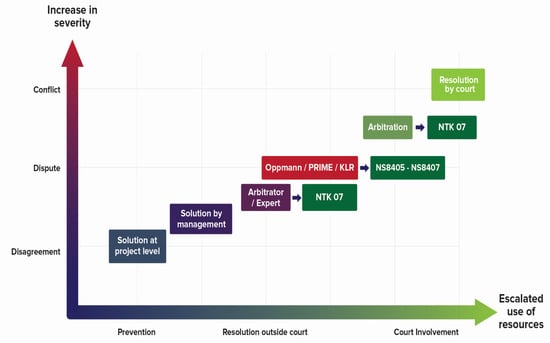
Figure 2.
Development of the use of resources in construction conflicts; reproduced and updated [].
Using the arbiter “oppmann” technique is the preferable choice (for some years despite the will to use new methods) of the Norwegian Public Roads Administration (NPRA), which views that the final settlement will be a time and the place for negotiations on unsettled issues accumulated during construction time [,]. Hence, it is expected that unresolved issues pile up and remain until the final settlement.
It is known that continuous reporting provides reassurance that the settlement is correct [], and furthermore, it enables the contractor to substantiate justification for the remuneration adjustment. Norwegian standards dictate that the contractor must send a weekly report with specified accrued costs to the client. Documentation related to disputes is crucial, particularly with the passage of time. In many cases, public clients are not satisfied because contractors argue that it is difficult to document everything during construction [,].
1.1.7. Awarding Tenders: Best Value Procurement
Awarding tenders at a lower price as the sole criterion was a source of dispute in the Norwegian construction industry [] for which the best value procurement (BVP) method [] was a proposed solution. Based on the “information measurement theory”, which states that the more information you have available, the easier you can predict the future [], a portfolio assessment of the tenderer is usually conducted to ensure that the project will be carried out in line with desired values and objectives []. It will also offer a competitive basis for a thorough tender process. Thus, BVP emphasizes the supplier’s competence and performance [,] that ensures contractors deliver excellent results measured on more points than just the best or lowest price offered. BVP has certain disadvantages; firstly, the public client must comply and act as per the regulations on public procurement [] concerning an interview assessment of the contractor’s credibility related to the delivered offer. Secondly, there is uncertainty on how the various criteria, including price, should be weighed to provide the best possible competition to ensure competition. The EBA has recently presented a request for several measures as a basis for competition to the Norwegian Minister of Transport and Communications [].
Despite these disadvantages, the Dutch Public Roads Administration (Rijkswaterstaat) showed that using BVP decreased the time spent on contract follow-up by 50% (Blytt, 2019), reducing project implementation time by 25%. Importantly, compared to the processes used prior to BVP, fewer change notifications, faster processes, and fewer conflicts were reported in Norway [].
While there is more pressure on public clients to use other criteria than price, some players are less receptive as questions arise on how to weigh the various criteria [] and whether weighing of price is central. While price must be weighed heavily as the projects are financed with tax money, weighing competence will help develop the players’ level of competence, as the focus is no longer on prices or prices at a reduced level. Nevertheless, BVP is slowly gaining access in the Norwegian market. Moreover, because of the intense competition for roads and tunnel projects in Norway, the lowest price is the norm in tendering, affecting profitability with margins shrinking [].
1.1.8. Awarding Tenders: Two-Envelope System
The two-envelope system is an alternative to BVP, wherein tenderers deliver two envelopes with proposals—implementation and price. The envelope with proposals for implementation is opened first, and then the tenderers are ranked. Next, the envelope with the price is opened. All bidders thus receive an overall score, and the one with the best score wins the tender [].
Differences between BVP and the two-envelope system show that while the contractor is engaged early with BVP, the client does not present the budget in advance in the two-envelope system. Each envelope has weight with a 50% distribution, whereas, in BVP, other factors influence the outcome, with price having a secondary role [].
1.1.9. IPD—Integrated Project Delivery
Integrated project delivery (IPD) is a method that engages clients, consultants, and contractors throughout the process, from design to completion, and has been used extensively in hospital construction in the USA and for few years in heavy construction projects in Norway. This method utilizes talent and insight to optimize efficiency and reduce losses [] and integrates people, systems, and business structures in the process []. Because all stakeholders gain early insight into the project and collaborate to choose the optimal solution, there is better control over costs, preventing significant surprises and changes during the project []. Indeed, IPD has been used in several countries and has proven to be an effective model for executing projects [].
Because the focus of IPD is the joint result of the project and not selfish desires, profits are combined into a single stakeholder’s pot, thereby not benefitting contractors and preventing them from rectifying requirements that squeeze every penny from the client []. The process involves deriving a target price that all stakeholders actively attempt to attain, along with bonuses and surcharges, which comprise the total estimated project cost [].
Suppose the project delivered is below the target price. In that case, the stakeholders have a distributed cost saving that goes to the bonus, which is distributed between themselves based on achievement of goals and extent of cost savings []. An IPD remuneration model implemented in Norway is shown in Figure 3. The bonus comprises a small part of the target price. On the contrary, the profit is affected if costs are exceeded, but a daily fine is never applied []. When adopted in Finland, where IPD was demonstrated to be a well-functioning model, only 1 of 48 projects executed over a 6-year period and costing EUR 3 billion went above the target price [].
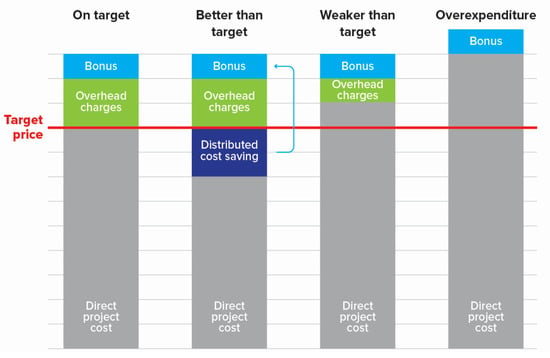
Figure 3.
Remuneration model of Norwegian Integrated Project Delivery Model, reproduced [].
1.1.10. PRIME and KLR (Dispute Review Board)
In Norway, disputes cost society, clients, and contractors several billion kroner a year [], and it can take up to 1.5 years in Norway to have a case processed []. This situation not only leaves an unpleasant taste in the mouths of those who are owed but can end new investments due to locked-in capital and repayment of VAT for claimed money []. Therefore, the need for traditional methods of preventing disputes from escalating into intractable conflicts that would end up in court has never been greater.
The Norwegian standards stipulate that conflicts should be resolved before they go to court, and summonses must be issued before any arbitration or expected trial. The Conflict Resolution Board, or KLR if translated literally, in reality is the Norwegian version of the DRB [] that inspired both PRIME and KLR, with no differences in their implementation; however, they can differ in the committee that they comprise—their composition, qualifications, number, and the extent of their involvement [].
According to NS8407, stakeholders can engage a team of experts that act as a mediation group and conflict resolution board during the contract period for design-build contracts. This proactive measure engages stakeholders during early discussions and initial stages to prevent disputes instead of applying a corrective solution after a conflict begins [].
There are numerous methods to resolve disputes. Mediators in DRB, used in the US, present a recommended solution if both parties agree. If one party disagrees, the conflict is not resolved, and if no agreement is reached, the normal process according to DRB regulations is adopted []. With the Dispute Adjudication Board (DAB), which is an Alternative Dispute Resolution (ADR) that is widespread in the United Kingdom [,], the board’s decisions are binding.
The mediation committee using PRIME can consist of up to three people that are usually individuals with a legal or engineering background [] and are chosen in consultation between the client and the contractor, who also determine the extent of the mediators’ involvement. The mediators decide the outcome of disagreements as seen in DAB or only act as advisers as in the DRB []. The advantage of using PRIME is that the threshold is low when resolving disagreements, preferably before the stakeholders’ relationship is affected negatively, as both parties have agreed to use this method.
Within the context of Norway, the NPRA used KLR in the Bjørvika project [], whereas New Roads (Nye Veier), which is smaller than NPRA [] preferred PRIME. A significant number of cases of disagreements in the Bjørvika project were resolved without using the judiciary system []. Likewise, New Roads (Nye Veier) have had zero disputes since 2015 [] as of the writing of this report.
The variety in dispute resolution methods and a lack of standardized contracts have prolonged disputes that cost society dearly. The objective of this study was to identify how disputes can be prevented from occurring and how the surge in conflicts in the Norwegian construction industry can be reduced. A CAPA (corrective and preventive analysis) was performed using the eight disciplines (8D) problem-solving procedure as the chosen framework to achieve this goal.
2. Methodology
In this chapter, three main objectives will be discussed: first, the study design and what the focus of this study is; second, how data were collected and in how many phases; the third is what approaches were used in order to analyze the data; and last but not least, and as the title of this study shows, a corrective and preventive study (CAPA) always uses one of the different CAPA frameworks, in our case, the 8D procedure is used and will be discussed.
2.1. Study Design
The purpose of this study is to identify how to prevent disputes in construction projects in Norway. A qualitative analysis [,] of 58 formal, semi-structured interviews was conducted with the Norwegian construction industry’s experts, comprising contractors, public clients, consultants, academics, and lawyers. The experts have at least 20 years and some of them more than 40 years of experience in road and tunnel construction contracts disputes in the Norwegian construction industry. This study involved a few executives, including CEOs and public sector members from agencies such as Bane NOR, New Roads, and NPRA. Lawyers, who generally have differing views on whether to follow the traditional or ADR methods [] to resolve construction disputes, were selected based on their expertise. Participant selection followed the guidelines based on scientific research methodology [].
Since there is an absence of an existing database of dispute events in Norway, it was obvious to start collecting data and gathering information for this study.
2.2. Data Collection
Data for this qualitative analysis were collected in three phases—(i) first phase (2017) []; (ii) second phase conducted in spring 2018 and comprised two teams, at two different times [,]. Phase one and two were used to map the causes and impacts of disputes in heavy construction projects in previous studies. Phase three was conducted to map out how to prevent and resolve conflicts in construction projects in Norway and is used in this study. The third phase of data collection in spring 2019 was implemented to comprehensively investigate disputes in construction projects in Norway. The third phase was performed comprising closed- and open-ended questions posed to 58 respondents to determine their individual experiences. Each respondent was asked 21 questions to determine the primary causes, consequences, preventive measures, and resolution techniques of conflicts in Norwegian construction projects. For objectivity, all responses were catalogued, regardless of their oddity or peculiarity, and compiled. Responses were tabulated for use in the present study, and future purposes are irrelevant to the current research question [,].
In response to input from the construction industry, the Norwegian Association of Heavy Equipment Contractors (MEF) conducted a survey of 1799 of its members in early 2018 to determine the reasons for payments blocked by the NPRA and other related issues regarding disputes in construction projects in Norway. Results from the MEF survey were used in this study as well []. In addition to the previous, NPRA shared with us data on conflicts between 2008 and 2018 that were resolved either through ADRs or the Norwegian court system.
2.3. Data Analysis
The data were gathered by emerging contexts and then subsequently categorized according to different themes. Data were coded using NVIVO 12.0 [], a qualitative data analysis (QDA) software, following specific relevant themes and thematic maps. Data were plotted as described previously [], and a representative visualization of the data was obtained using Python version 3.8.5, which allowed for detailed graph customization and contained extensive library support []. The Anaconda data science platform, which has most of the required software and libraries pre-installed and Jupyter Notebook IDE (Integrated Development Environment), an open-source web application specifically designed for data analysis to quickly and intuitively focus on one visualization at a time, were utilized to examine qualitative data through the use of visualizations [].
Four concepts that were previously identified as the root causes of conflicts [] were examined in the current study:
- (i)
- Tender specification and contract understanding;
- (ii)
- Final settlement—payment;
- (iii)
- Changes orders and changes in projects;
- (iv)
- Low-priced contracts.
2.4. The 8D Process to Prevent Disputes in Construction Projects
The 8D is a systematic approach to prevent and solve problems and confusion throughout the project within a company or an organization [] through problem identification and rapid response by maintaining flow and consistency. The 8D approach establishes proactive actions for eradicating root causes by implementing permanent corrective actions, as described previously []. Unique solutions to specific problems are constantly modified and maintained as models. Though the 8D approach was never meant to be a substitute for a comprehensive quality management framework, the goal is to confront problems and identify the management system vulnerabilities that enabled the problem to arise in the first place []. The problem could originate from anywhere, as long as the project is considered significant enough to warrant forming a team to work on it [].
As described, the first step (D0) of the 8D method is to identify the problem, followed by preparation and initiation. Usually, a team leader should be assigned, but in this study, the main author is the coordinator, and the following steps were undertaken:
- Identification of the team (interviewees in our case) that included public clients, private contractors, consultants, lawyers, and academics;
- Problem description—The 5W2H (Who, What, When, Why, Where, How, How (many or much) to systematically understand the issue. The 5W2H were embedded in our survey questions;
- Immediate action to be made in normal 8D process, but in this study, a recommendation is to be advised;
- Identification of causes of disputes in order to set a procedure for preventing disputes. Cause of disputes have been identified in an earlier study related to this study [];
- Corrective actions to be advised;
- Measuring effectiveness (based on experience of interviewees) can give a reliable score to results of the 8D used here;
- Expansion in normal cases, this can be done in future 8D building on our results;
- Conclusion of the study, as mentioned in the end of this study.
3. Results
In this section, the results collected from interviews and the MEF study will be presented and commented upon. How the results were achieved will be reviewed, and a visualization of the data will be presented.
3.1. Defining Themes
In this study, text received from interviews were coded. In order to make the process of coding and processing of text more professional, NVIVO 12.0 was used, as mentioned in the methodology chapter. Since NVIVO is involved, themes had to be identified in order to go further in the mapping process.
3.1.1. Theme 1: Tender Specification and Contract Understanding
A contract is considered an essential document for assessing claims as the contract parties abide by the terms of the contract, follow through with construction processes, and stipulate dispute resolution. The first theme (Figure 4) showed that documentation represented responsibilities for everyone in the contract, thereby creating a distinction among people responsible for specific tasks or indicating a joint responsibility.
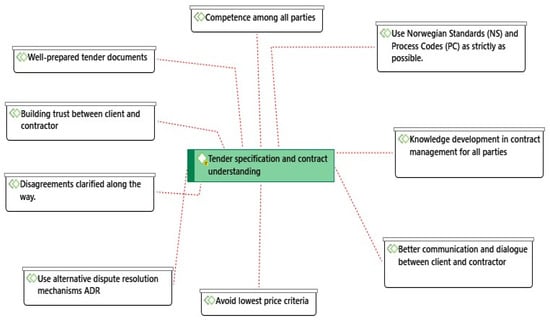
Figure 4.
Thematic map 1.
Since financial disagreements cause disputes between clients and contractors, proper transparent budget management should be considered during the negotiations with all contracting parties, thus building confidence between clients and contractors [].
To resolve any dispute, based on our findings, negotiation among the conflicting parties should involve better communication and dialogue that should be adopted in the contract agreement between parties leading to a joint decision []. Dissatisfied clients and contractors prefer to write a suggestion or privately communicate with the owners and parties to find common ground through communication [].
3.1.2. Theme 2: Final Settlement—Payment
As shown in Figure 5, the respondents considered establishing a good construction management process through which significant claims and conflicts are identified, with parties responsible for each aspect and cost of the claim. Therefore, an effective way of dealing with payment issues unfavorable to the lower-tier parties was recommended. Since delays in final payment pose a barrier to a project’s success, it creates misunderstanding and a breach of trust among parties []. To overcome this, following the contract’s legal terms and conditions, the ideal starting point for real solutions to payment disputes was establishing trust among parties, followed by flexibility in attitude among construction parties. It is known that a well-prepared tender document stating the duration of payments, terms involved, and sharing ratio among parties creates an act of transparency with an overview of all stakeholder entitlement in the construction activities [].
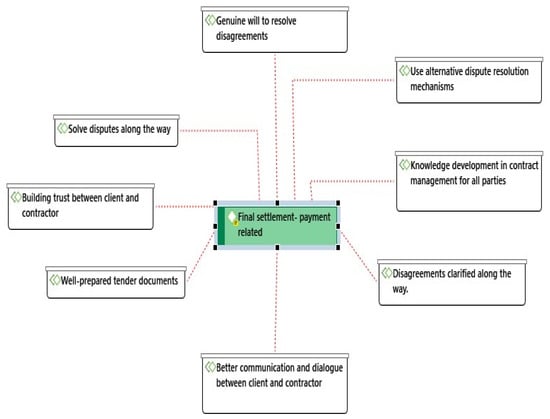
Figure 5.
Thematic map 2.
3.1.3. Theme 3. Changes Orders and Changes in Projects
It was observed that respondents involved in resolving disputes related to changes order and changes in projects and those with considerably more experience considered a good routine in handling changes in the project to be most significant (Figure 6). Therefore, in the absence of proper planning and sufficient routine to increase the contractors’ choice of needs, which changes the project’s requirements, conflicts are unavoidable due to changes in projects [].
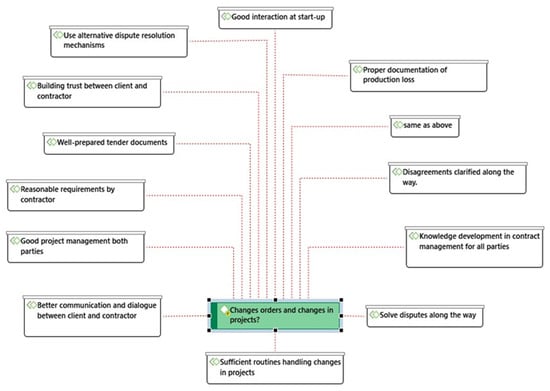
Figure 6.
Thematic map 3.
A key respondent identified the need for knowledge development in the construction industry in general. Furthermore, understanding the details of a project and management through proper documentation of production loss can alleviate the consequences of sudden changes [,].
3.1.4. Theme 4. Low-Priced Contracts
As shown in Figure 7, there were varying responses on how disputes related to low-priced contracts could be resolved. First, assessing contractors’ abilities in prequalification tests on the field, based on essential criteria, can be relied upon to cost their competencies and avoid bias in the payment of workers’ salaries/wages. Second, BVP steers the client to trustworthy and reliable contractors, fostering harmony among stakeholders, which corroborated the concept that BVP can be used for contract-awarding methods with the highest level of expertise from the public-client side for addressing the lowest tender complication [].
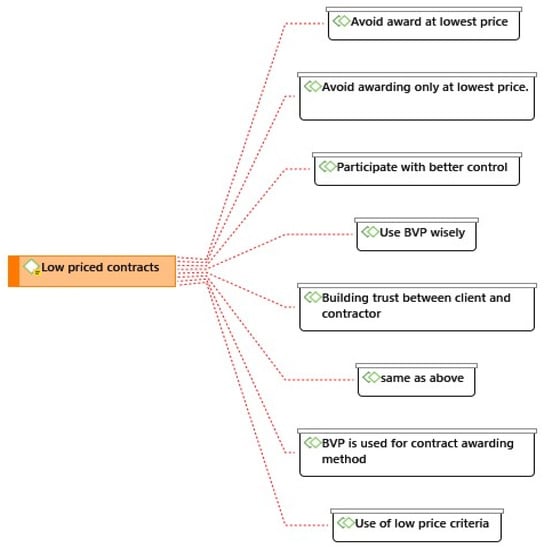
Figure 7.
Thematic map 4.
Additionally, better communication between parties from the beginning of the contract creates an avenue for mutual understanding in the process and helps to avoid disputes. Therefore, adopting an “adequately built” contract that can serve as a blueprint to follow may prevent misunderstanding [].
The Python Anaconda Jupyter (PAJ) analysis (Figure 8, Figure 9, Figure 10 and Figure 11) showed interrelationships across the selected variables. Respondents either showed significant agreement regarding how the industry should behave to achieve maximum dispute prevention and what can be done to improve the discussed processes in the future and/or to avert an apparent disagreement among the involved parties.
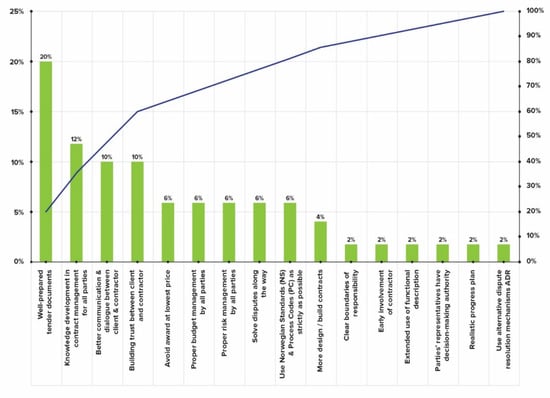
Figure 8.
Pareto diagram showing disputes prevention techniques related to the tender specification and contract understanding.
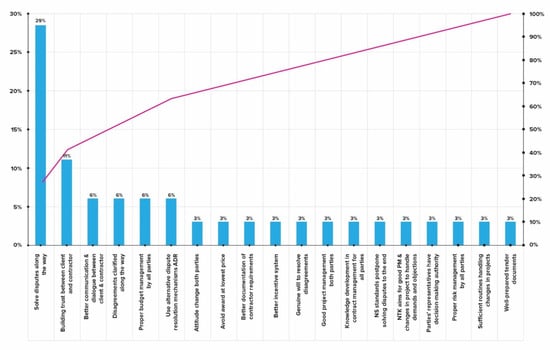
Figure 9.
Pareto diagram showing disputes prevention techniques related to final settlement—payment related.

Figure 10.
Pareto diagram showing disputes prevention techniques related to changes orders.
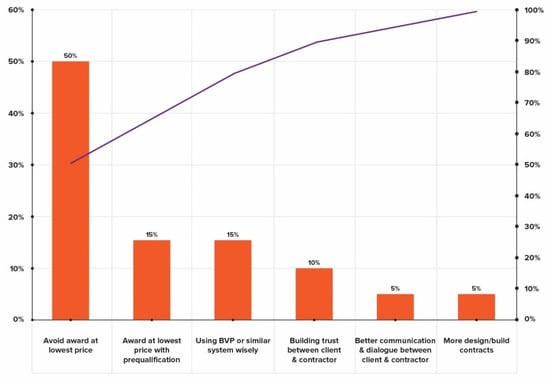
Figure 11.
Pareto diagram showing disputes prevention techniques related to low priced contracts.
3.2. Corrective and Preventive Action Plan
Three processes formed the crux of this qualitative analysis:
The first process examined existing experiences and theories to draw a reasonable visual understanding of the current situation regarding the prevention of disputes in construction projects. The second process analysed the data gathered from the field in Norway. The third process used the 8D method as the chosen framework to implement CAPA. The findings from the 8D method were:
- Participants with expertise were identified;
- The construction industry had been incurring increasing losses for the previous 10 years, which was a determining point for those involved in the construction industry in Norway to take action;
- The immediate short-term action was to improve the tender document preparation process because it is a root cause of disputes within the industry [];
- While most disputes arose from tender specification and contract misunderstandings, there were other significant reasons related to payment and changes orders;
- Corrective actions suggested included a new method to produce better-prepared tender documents to prevent disputes related to tender specification, knowledge development in contract management for all parties involved, training to ensure better communication and dialogue between clients and contractors, and enhance capabilities that will pave the way for better trust-building between parties. Corrective actions to avoid disputes in final settlement (payment related) were to solve disputes along the way and build trust between clients and contractors. To prevent disputes related to changes orders, better communication and dialogue between client and contractor was proposed. To prevent disputes related to low-priced contracts, contracts should generally not be awarded at the lowest price or adopt a hybrid model;
- The effectiveness of the CAPA established in this study should be measured using a tracking procedure for a few years as determined by the committee established in step one to measure the feasibility and conformity of the measures being implemented accordingly;
- Applying the CAPA as described in this study may reduce the number of disputes within a year after implementation. Public organizations should have updated mechanisms of awarding contracts at the lowest price to enhance the tender document preparation process;
- In addition to congratulating the team that implemented CAPA, employees should be trained to minimize the number of disputes, upskill personnel to produce tender documents, and provide coaching to employees in communication and building trust finesse.
3.3. Preventing Disputes Related to the Tender Specification
The tender specification is a significant issue for causes of conflicts []. Several Pareto diagrams, also known as the 80/20 rule, were produced in this study. Pareto diagrams help map and identify the main measures with the most significant consequences that can be used in order to prevent disputes [].
Results in this study show that well-prepared tender documents contribute about 20% (given the cumulative percentage) of the ways to avoid disputes related to tender specifications and contract understanding (Figure 8). Results also indicated that better contract management and understanding would contribute positively to dispute prevention. Knowledge development in contract management, better communication, and building trust between clients contributed to 52% of the overall prevention of disputes, given the cumulative percentages.
Respondents noted that contracts, documents, and descriptions must be prepared to be congruent with the construction sector expectations. This leads to more interaction before project initialization and will enhance the understanding of contracts. A side effect of all of this is to avoid competing solely on price but rather the value that would be delivered.
In addition, the selection of delivery method and contract type is significant. These approaches could bring both parties (client and contractors) to the point of agreement. Some of the respondents insisted that matching the contract documents that NTK07 (NTK15) provides would provide a better foundation than the current scenario using other types of Standards.
3.4. Preventing Disputes Related to the Final Settlement
To avoid disputes related to the final settlement and payment-related disputes, 29% of the respondents indicated that cooperation and solving disputes along the way was key (Figure 9). To achieve this in practice, loyalty and adherence to KLR/PRIME conflict resolution methods were suggested, which would demonstrate the parties’ professionalism and promote their favorable image throughout the construction sector.
3.5. Preventing Disputes Related to Changes
Participants demanded better documentation of the changes, indicating that many contractors and public clients see changes as one of the root causes of disputes in the final settlement. Our analysis showed that the industry disagrees more in this regard than in the previous questions. The distribution of various proposals (Figure 10) showed that routines and descriptions need to be improved, and many clients also mentioned that contractors must become better at documenting the changes. Though an unambiguous response was not forthcoming, most participants considered that the right project description could prevent disputes related to changes. Better communication and dialogue between client and contractor was considered by 22% of the survey participants to prevent disputes. The factors considered important to prevent disputes related to changes orders included proper contract management from both parties, better communication, better knowledge, swift action, and trust. Corroborating these findings were the outcome of the MEF survey, which showed that changes in projects and the consequences ascribed to it were the most repeated cause of conflicts between entrepreneurs and public clients [].
3.6. Preventing Disputes Related to Competition Based on the Lowest Price
Our findings related to low-priced awarded contracts showed that respondents proposed avoiding awards at the lowest price, on which it contributed about 50% (given the cumulative percentage) to the total dispute preventions suggested mechanisms (Figure 11). Whereas most participants were skeptical of the lowest price, lawyers and the consultants were unanimous about their position about the lowest price. On the other hand, respondents argued that the lowest price was feasible, but its implementation is fraught with dissension. Thus, there is a need for mutual agreement between contractors and clients to enhance project awards and implementations. This, then, will mitigate disputes in construction projects. There was significant agreement that it was no longer desirable to have the lowest price as the only criterion. Contracts have grown to a large extent, and projects are full of complications and uncertainties. However, it cannot be generalized that the lowest price was wrong in all projects and should be considered case-by-case. Many projects have used the lowest price tendering, which was successful and dispute-free []. Therefore, a different basis for the tendering process should be regarded as to ensure profits and sustainability for Norwegian stakeholders.
4. Discussion
A comprehensive qualitative analysis was performed to achieve our study’s goal of identifying how to prevent disputes in heavy construction projects in Norway. Qualitative analysis of data from interviews using NVIVO 12.0 helped reach a logical conclusion. NVIVO is a widely used qualitative and mixed-methods research tool used specifically for unstructured text such as interviews. A previous study investigated [] the cause and impacts of conflicts in heavy construction projects and identified four main reasons as being responsible for more than 60% of all disputes in Norway. These four causes of disputes that were attributed to most of the conflict cases were the focus of this study.
Analysis of data and text using NVIVO identified four causes, shown in Figure 4, Figure 5, Figure 6 and Figure 7, which formed the roots of the main four themes in NVIVO. These four themes defined the measures used for preventing future disputes. The main NVIVO themes were categorized and processed using Python Anaconda Jupyter (PAJ) to generate reliable, visualizable, comprehensible, and presentable data. The main intention behind using Python to generate Pareto diagrams is that it easily shows the root schemes and their relation to each of the four main themes. This exercise generated four Pareto diagrams (Figure 8, Figure 9, Figure 10 and Figure 11) that presented the coded answers of all the text retrieved from the respondents. In addition, there is an overlap between the root schemes, as demonstrated in Figure 8, Figure 9, Figure 10 and Figure 11. We included the results from MEF in these data, which was an important source of data for this study as well.
Disputes related to tender specifications was the first theme, within which four measures can be used to prevent disputes in construction projects, as shown in Figure 8. These are (i) well-prepared tender documents; (ii) knowledge development in contract management; (iii) better communication and dialogue between public owner and contractors; and (iv) building trust between the client and the contractor.
Preventing disputes related to final settlement was the second theme, within which there were six recommendations that emerged, as shown in Figure 9. These were (i) the importance of solving disputes along the way and not waiting until things exacerbate; (ii) building trust, which overlaps with measures from the first theme; (iii) better communication, which overlaps with measures from the first theme; (iv) early clarification of disagreements; (v) proper budget management; and (vi) use of proper alternative dispute resolution mechanism that aids in the prevention and resolution of disputes if needed.
Disputes related to changes was the third theme, within which three main avenues can be used. These were (i) better communication; (ii) solving disagreements along the way; and iii) knowledge development in contract management for all parties involved. It must be noted that there is considerable overlap between these avenues and recommendations connected to different themes.
Competition based on the lowest tender price was the fourth theme, within which the principal recommendations were to avoid resorting to awarding contracts based on lowest price, or lowest price but with prequalification or using Best Value Procurement (BVP) system wisely and carefully. These recommendations were root measures identified from coded answers among many that were proposed. The survey respondents considered these three recommendations as significant enough to abrogate disagreements related to awarding tenders to lowest price.
Thus, our analysis found an overlap of the three root measures—knowledge development in contract management for all parties involved, better communication between the public owner or (the owner in general) and the contractor, and building an environment and atmosphere of trust between parties involved in the construction process—and the four themes identified in this study.
The construction industry’s shortcomings are time and trust required for contracting implementation and conflict prevention, which, if enabled, achieves transparency between parties and create trust. The advantages and disadvantages of methods discussed earlier are demonstrated in an implementation model (Figure 12), which is similar to New Roads’ (New Veier) model, which facilitated New Roads to prevent disputes in all their projects as of March 2022.
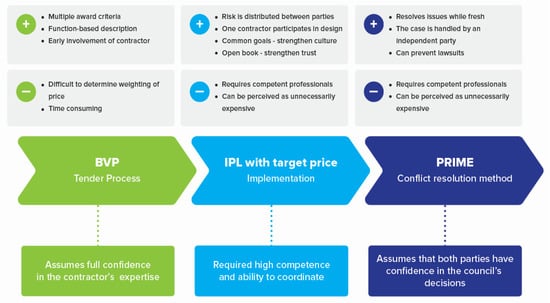
Figure 12.
Suggested methods to prevent disputes in construction projects.
Lack of trust among stakeholders in the construction industry is the result of an inability to change attitudes and culture, withholding information, poor integration, and reliance on price rather than award criteria. This asymmetric distribution of information can be avoided through better cooperation, healthier contracting environments, and adopting best practices that allow parties work towards a typical target price.
Strengths of the Study
Participants’ responses were evaluated to identify elements that can be incorporated into CAPA processes to minimize disputes in the construction industry. The elements identified were:
- (i)
- Communication, which has become a natural part of the implementation model [] for new delivery methods, such as IPD or collaboration contracts with incentives. By coming together in early phases, participants help design concepts and goals that enhance understanding, create trust, and build healthy relationships between the parties;
- (ii)
- Using a two-envelope system has gained support from contractors and public clients [];
- (iii)
- The use of award criteria rather than price enables the client to understand the contractor’s ability to implement solutions for the process. The client can also influence the optimal solution in consultation with the contractor []. The target price also strengthens cooperation between the parties, as they work towards a common goal [], which helps build the client’s confidence in the chosen solution;
- (iv)
- Change orders and the challenges that follow must be handled through a joint commitment from all stakeholders. Use of the Norwegian Standards (NS versions) rather than NTK07 (the updated version NTK15) might lead to uncertainty due to the structure of contract documents following changes []. Alternatively, the NS packages currently available should be updated;
- (v)
- Price as the only award criterion should be abandoned or avoided because there is considerable agreement on the use of other award criteria [] with optimal results obtained from other countries [];
- (vi)
- KLR and PRIME are the most valued conflict-resolution methods in general [].
The primary determinant (tender specification and contract understanding) significantly impacted final settlement payments, changes order, and low-priced contracts on construction projects, showing the interconnectedness between variables and their relationship with the objective of this study [,]. The thematic map shows the relationships between emerging codes within each theme.
To summarize, by qualitatively examining conflicts, claims, disputes, and distinctions through a thematic analysis, we have identified approaches to prevent conflicts and avoid disputes in construction projects.
5. Conclusions
Disputes in construction projects have become a common occurrence, and usually, these start as minor disagreements that grow out of proportion with time, ending up in courts. Due to the enormity of the problem, there is considerable gain for the construction industry to identify methods to prevent disputes and develop mechanisms to help resolve conflicts. Our study has achieved these aims through a thematic analysis, which identified that the prevention of disputes in Norwegian construction and infrastructure projects can be achieved through good implementation routines, more explicit standards, desire for cooperation, and respect.
The lack of a balanced interaction between clients and contractors during the early stages of project implementation leads to a vague and unclear distribution of responsibilities, giving rise to conflicts. The 8D approach revealed that problem solving is continuous and not a one-time process. In addition, the dynamic nature of the construction industry where new rules are implemented should meet new challenges. Improved routines that drive down costs, boost cooperation, and new forms of tendering and contracting are keys to minimizing disputes, improving gains among parties involved, and establishing a sustainable contracting environment that form pillars of the future construction industry.
To the best of our knowledge, our study is the most comprehensive investigation in the prevention of conflicts and their resolution in Norway. A roadmap that enables the implementation of the methods identified in our study to any construction environment (Figure 12) may see benefits when employed prudently. Our findings have global implications, as these methods can be implemented in other parts of the world with ease. However, every country has its own construction culture, and therefore, our solutions can be adapted with modifications to enable a proper fit.
Author Contributions
O.K.S. have written, researched topic and gathered data, and O.T. have given important comments, feedback and writing in order to make this article ready for publishing. All authors have read and agreed to the published version of the manuscript.
Funding
The Norwegian University of Science and Technology is funding this publication.
Institutional Review Board Statement
Deputy head of department of civil and environmental engineering has reviewed and given his consent to this publication.
Informed Consent Statement
Deputy head of department of civil and environmental engineering has reviewed and given his consent to this publication.
Data Availability Statement
Not applicable.
Conflicts of Interest
There is no conflict of interest in this article and all our future articles.
Abbreviations
| Bane NOR | Norwegian National Rail Administration |
| Difi | Agency for Public Management and eGovernment |
| DRB | Dispute Review Board |
| EBA | Association of Building and Construction Contractors |
| IDP | Integrated project delivery |
| KLR | The Norwegian version of Dispute Review Board (DRB) |
| MEF | Norwegian Association of Heavy Equipment Contractors |
| New Roads (Nye Veier) | Second largest public roads administration in Norway. |
| NOK | Norwegian crowns |
| NPRA | Norwegian Public Roads Administration |
References
- Giske, A. Where Veidekke want to go. Veidekke AS. In Proceedings of the Oslo: Conference of Conflicts in Building and Construction, Oslo, Norway, 29 November 2018. [Google Scholar]
- Aga, F. In 2015, the Norwegian Public Roads Administration Received Almost 100 Offers from Norway’s Largest Contractor—in Last Six Month of 2018 Received Three. 2019. Available online: http://www.bygg.no/article/1391214 (accessed on 20 August 2019).
- Sabri, O.; Bruland, A.; Lædre, O. Why conflicts occur in roads and tunnels projects in norway. J. Civ. Eng. Manag. 2019, 25, 254–264. [Google Scholar] [CrossRef]
- Holter, J.H. Conflicts and Conflict Resolution Mechanisms in the Construction Industry; The Faculty of Law, University of Oslo: Oslo, Norway, 2019. [Google Scholar]
- Engen, L.E.B.; Sætha, E. Conflicts in the Construction Industry; Faculty of Engineering, Department of Civil and Environmental Engineering, Norwegian University of Science and Technology: Trondheim, Norway, 2020. [Google Scholar]
- NS 8407; General Conditions of Contract for Design and Build Contracts. Norwegian Standard; Standards Norway, 2011. Available online: https://www.standard.no/en/PDF/FileDownload/?redir=true&filetype=Pdf&preview=true&item=496101&category=5 (accessed on 15 March 2022).
- NS 8405; Norwegian Building and Civil Engineering Contract. Norwegian Standard; Standards Norway, 2008. Available online: https://www.standard.no/en/PDF/FileDownload/?redir=true&filetype=Pdf&preview=true&item=404323&category=5 (accessed on 15 March 2022).
- NTK 15; Norwegian Total Contract 2015. Norwegian Industry, Norwegian Oil and Gas: Stavanger, Norway, 2015.
- Isaksen, V.H. Trust and Conflict in Building and Construction Projects in Norway; Department of Civil and Environmental Engineering, Faculty of Engineering, Norwegian University of Science and Technology: Trondheim, Norway, 2019. [Google Scholar]
- Groven, V.; Hafskjær, S.; Ferstad, O.B. Disputes in Construction Projects in Norway; Department of Construction and Environmental Engineering, Faculty of Engineering, Norwegian University of Science and Technology: Trondheim, Norway, 2017. [Google Scholar]
- Bentås, Ø. Theory and Data Collection on the Disputes in the Construction Industry; Report number: 43-2018; Department of Civil and Environmental Engineering, Faculty of Engineering, Norwegian University of Science and Technology: Trondheim, Norway, 2018. [Google Scholar]
- Homleid, A. We Are in a Climate Where Confidence Is very Low. 30 August 2019. Available online: https://www.bygg.no/article/1405079 (accessed on 15 October 2020).
- Tveten, H. Overview & Analyses of Court Cases Related to Norwegian Underground Constructions; Department of Civil and Environmental Engineering, Faculty of Engineering, Norwegian University of Science and Technology: Trondheim, Norway, 2017. [Google Scholar]
- Gunnes, S. Disputes between Contractors and Owners: Owner Withholding of Payments; Norwegian Association of Heavy Equipment Contractors (MEF): Oslo, Norway, 2018. [Google Scholar]
- Mosti, K.-A. How to Handle VAT in Disputed Claims? 4 November 2019. Available online: http://www.bygg.no/article/1413421 (accessed on 11 October 2019).
- Broch, H.R.; Bergset, Ø. Contracts Award Criteria for Heavy Construction Projects; Nordic Road Engineering Association (Nordisk Vegteknisk Forbund), Norway: Oslo, Norway, 2008. [Google Scholar]
- Seehusen, J. Veidekke Manager: Inexperienced People have Contributed to Road Conflicts for 400 Million. 11 November 2013. Available online: https://www.tu.no/artikler/veidekke-sjef-uerfarne-folk-har-bidratt-til-veikonflikter-for-400-millioner/233680 (accessed on 16 October 2019).
- Johansen, T. About Contract Follow Up. 23 October 2019. Available online: http://www.bygg.no/article/1412347 (accessed on 24 October 2019).
- Homleid, A. Lawyers will Have Requirements for Contract Follow up to Reduce the Level of Conflict in the Construction Industry—Bane NOR and the Norwegian Public Roads Administration lukewarm to the Proposal. 21 October 2019. Available online: https://www.bygg.no/article/1411871 (accessed on 22 October 2019).
- Opsahl, H.O. Norwegian Experiences with Different Implementation Strategies in Large Infrastructure Projects; Department of Construction and Environmental Engineering, Faculty of Engineering, Norwegian University of Science and Technology: Trondheim, Norway, 2015. [Google Scholar]
- Lædre, O. Contract Strategy for Building and Construction Projects in Norway; Fagbokforlaget: Bergen, Norway, 2009. [Google Scholar]
- Kongsmo, A.; Bjørhusdal, T. KLR in Transport Projects—A Tool for the Future; Construction and Transport. (Incl. Appendices): 138; Faculty of Engineering, Norwegian University of Science and Technology (NTNU): Trondheim, Norway, 2013. [Google Scholar]
- New Roads, Implementation Model. 25 October 2016. Available online: https://www.nyeveier.no/om-nye-veier/gjennomfoeringsmodell (accessed on 11 November 2019).
- Myrold, O.G. Facilitation of the Use of NTK 07 in Norwegian Road and Transport Projects; Department of Construction and Environmental Engineering, Faculty of Engineering, Norwegian University of Science and Technology: Trondheim, Norway, 2016. [Google Scholar]
- Myrold, O.G.; Lædre, O. Can NTK 07 Replace NS 8407? Byggeindustrien: Oslo, Norway, 2016; Volume 15, p. 37. [Google Scholar]
- Thronæs, F.S. Incentive-Based Engineering Contracts in Construction Projects; Department of Mechanical and Industrial Engineering, Faculty of Engineering, Norwegian University of Science and Technology: Trondheim, Norway, 2018. [Google Scholar]
- Offergaard, S. Can Save Huge Sums with Mediation; Byggeindustrien: Oslo, Norway, 2 August 2017. [Google Scholar]
- Kaasen, K. Project Integrated Mediation (PRIME). In Contracts in Norwegian Tunnelling; Norwegian Tunnelling Society: Trondheim, Norway, 2012; pp. 69–79. [Google Scholar]
- Lædre, O. Is There a Problem? Prevention and Management of Disputes in Construction Projects, 2nd ed.; Fagbokforlaget Vigmostad & Bjørke AS: Trondheim, Norway, 2015. [Google Scholar]
- Bjørvig, K. Where Do We Stand, Where Do We Go? Statens Vegvesen: Oslo, Norway, 2019. [Google Scholar]
- Sulland, S.; Larsen, S. Changes, Especially Regarding Documentation. 21 November 2017. Available online: http://www.bygg.no/article/1334722 (accessed on 29 October 2019).
- Henning, J.E. Selection of Contract Type and Mechanisms for Conflict Management; Norwegian Public Roads Administration: Oslo, Norway, 2019. [Google Scholar]
- Arendt, T. Legal Issues Related to Best Value Procurement (BVP). 31 May 2018. Available online: https://www.anskaffelser.no/sites/anskaffelser2/files/klug-2010619-v1-klug-2009618-v2-20180530_best_value_procurement_-_utredning_av_rettslige_sporsmal_0.pdf (accessed on 22 October 2019).
- Bruno, T.; Gelderman, C.J.; Lambrechts, W.; Semeijn, J. The promise of Best Value Procurement: Governance and (in) stability of specifications within an innovative biogas project. J. Clean. Prod. 2018, 172, 1465–1475. [Google Scholar] [CrossRef]
- Högnason, G.O. Best Value Procurement: Experiences from Building and Construction Projects in Norway; Department of Civil and Environmental Engineering, Faculty of Engineering, Norwegian University of Science and Technology: Trondheim, Norway, 2018. [Google Scholar]
- Mavropoulos, S.K.B. Public Procurement: Contemporary Construction Industry Practices and Best Value in Norway; Department of Civil and Environmental Engineering, Faculty of Engineering, Norwegian University of Science and Technology: Trondheim, Norway, 2017. [Google Scholar]
- Anskaffelser.no, Best Value Procurement (BVP). 14 October 2019. Available online: https://www.anskaffelser.no/hva-skal-du-kjope/bygg-anlegg-og-eiendom-bae/best-value-procurement-bvp-prestasjonsinnkjop (accessed on 22 October 2019).
- Bentzrød, S.B. Construction Disputes between the State and Contractors Cost Society 2.2 Billion a Year; Aftenposten: Oslo, Norway, 27 September 2018. [Google Scholar]
- Blytt, C. Best Value Procurement (BVP); Difi: Oslo, Norway, 2019. [Google Scholar]
- Nyseter, J.; Johnsrud, A. Best Value Procurement: A Contribution to More Efficient Construction Projects in the Public Sector; Department of Civil and Environmental Engineering, Faculty of Engineering, Norwegian University of Science and Technology: Trondheim, Norway, 2019. [Google Scholar]
- Angelsen, P.K. Integrated project delivery (IPD). In Proceedings of the Conference of Conflicts in Building and Construction, Oslo, Norway, 29 November 2018. [Google Scholar]
- Kent, D.C.; Becerik-Gerber, B. Understanding construction industry experience and attitudes toward integrated project delivery. J. Constr. Eng. Manag. 2010, 136, 815–825. [Google Scholar] [CrossRef]
- Multiconsult, First in Norway with IPD Contract for Hospital Construction. 13 March 2017. Available online: https://www.multiconsult.no/forst-norge-ipd-kontrakt-pa-sykehusbygging/ (accessed on 21 October 2019).
- Skaugen, P.H. Integrated Project Delivery in Public Norwegian Road Projects: Opportunities and Challenges; Department of Construction and Environmental Engineering, Faculty of Engineering, Norwegian University of Science and Technology: Trondheim, Norway, 2018. [Google Scholar]
- Ibenholt, K.; Kostøl, F.B. Calculation of Costs of Disputes in the Construction Industry, Socio-Economic Analysis, Association of Building and Construction Contractors. 2018. Available online: https://bit.ly/38eFF0X (accessed on 20 November 2019).
- Pétursson, B.K. Disputes and Conflicts within Construction Contracts in the Icelandic Construction Industry. Available online: https://skemman.is/bitstream/1946/22322/1/MSc_Thesis_Birkir_Kuld_Petursson.pdf%0Ahttp://skemman.is/en/item/view/1946/22322 (accessed on 15 March 2022).
- ARCADIS. Global Construction Disputes Report: Collaborating to Achieve Project Excellence, 10th ed.; Arcadis Publications: Amsterdam, The Netherlands, 2020. [Google Scholar]
- Sulland, S.; Roberts, C. Arbitration—Project-Integrated Mediation—PRIME; Byggeindustrien: Oslo, Norway, 17 January 2018. [Google Scholar]
- Alshenqeeti, H. Interviewing as a Data Collection Method: A Critical Review. Engl. Linguist. Res. 2014, 3, 39–45. [Google Scholar] [CrossRef]
- Attride-Stirling, J. Thematic Networks: An Analytic Tool for Qualitative Research; SAGE Publications: London, UK, 2001; Volume 1, pp. 385–405. [Google Scholar]
- Kisi, K.P.; Lee, N.; Kayastha, R.; Kovel, J. Alternative dispute resolution practices in international road construction contracts. J. Leg. Aff. Disput. Resolut. Eng. Constr. 2020, 12, 04520001. [Google Scholar] [CrossRef]
- Kothari, C. Research Methodology: Methods and Techniques, 2nd ed.; New Age International Ltd.: New Delhi, India, 2004. [Google Scholar]
- McCammon, B. Design Research Techniques. 2013. Available online: http://designresearchtechniques.com/casestudies/semi-structured-interviews/ (accessed on 15 January 2018).
- Creswell, J. Educational Research: Planning, Conducting, and Evaluating Quantitative and Qualitative Research, 4th ed.; Pearson Education, Inc.: London, UK, 2012. [Google Scholar]
- Ott, R.L.; Longnecker, M.T. An Introduction to Statistical Methods and Data Analysis; Cengage Learning: Boston, MA, USA, 2016. [Google Scholar]
- Nelli, F. Python Data Analytics: Data Analysis and Science Using PANDAs, Matplotlib and the Python Programming Language; Apress: New York, NY, USA, 2015. [Google Scholar]
- Krajnc, M. With 8D method to excellent quality. J. Univers. Excell. 2012, 3, 118–129. [Google Scholar]
- Banica, C.F.; Belu, N. Application of 8d Methodology—An Effective Problem Solving Tool in Automotive Industry; Scientific Bulletin, Faculty of Mechanics and Technology, University of Pitesti: Pitesti, Romania, 2019. [Google Scholar]
- Riesenberger, C.A.; Sousa, S.D. The 8D Methodology: An Effective Way to Reduce Recurrence of Customer Complaints. In Proceedings of the World Congress on Engineering, London, UK, 30 June–2 July 2010; Volume 3. [Google Scholar]
- Zarghami, A.; Benbow, D. Introduction to 8D problem solving. J. Qual. Particip. 2017, 40, 23–28. [Google Scholar]
- Baja, S.; Garg, R.; Sethi, M. Total quality management: A critical literature review using Pareto analysis. Int. J. Product. Perform. Manag. 2018, 67, 128–154. [Google Scholar] [CrossRef]
Publisher’s Note: MDPI stays neutral with regard to jurisdictional claims in published maps and institutional affiliations. |
© 2022 by the authors. Licensee MDPI, Basel, Switzerland. This article is an open access article distributed under the terms and conditions of the Creative Commons Attribution (CC BY) license (https://creativecommons.org/licenses/by/4.0/).